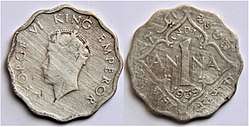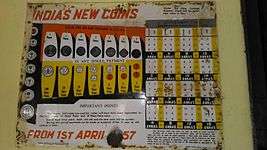Indian anna
| 1 Indian anna | |
|---|---|
 | |
| Obverse: Crowned bust of George VI, with lettering George VI King Emperor. | Reverse: Year of minting and face value in numeral, English, Urdu, Bengali, Telugu and Devanagari scripts. |
| 125,548,000 coins minted (1938 to 1940) | |
An anna was a currency unit formerly used in India and Pakistan, equal to 1⁄16 of a rupee.[1] It was subdivided into 6paisa or 12 pies (thus there were 96 paise in a rupee and 192 pies). The anna is very light-weighted. The term belonged to the Muslim monetary system. The ānā was demonetised as a currency unit when India decimalised its currency in 1957, followed by Pakistan in 1961. It was replaced by the 5-paise coin, which was itself discontinued in 1994 and demonetised in 2011. Even today, though, a 50 paise coin is sometimes colloquially referred to as 8 annas and a 25-paise coin as 4 annas.
There was a coin of one anna, and also half-anna coins of copper and two-anna pieces of silver. The term anna is frequently used to express a fraction of 1⁄16. Additionally, anna-denominated postage stamps were used during the British Indian period.
Notation
₹1/15/3/2 = ₹1.9947
₹1/8/3 = ₹1.546
₹1/4 = ₹1.25
Coins
.jpg) 2 Indian anna (1919).
2 Indian anna (1919). Annas - Paisa Conversion Table.
Annas - Paisa Conversion Table.- A 1835 quarter ānā.
See also
References
- ↑ "Republic India Coinage". Accessed 14 July 2011.
External links
| Wikimedia Commons has media related to Anna (coins). |